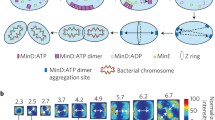Abstract
The following article is an edited transcript based on the MRS Medalist presentation given by Charles M. Lieber of Harvard University on December 4, 2002, at the Materials Research Society Fall Meeting in Boston. Lieber received the Medal “for controlled synthesis of nanowire and nanotube materials.” This presentation begins with an introduction to the bottom-up paradigm of nanoscience and nanotechnology. The key concepts of this paradigm are explored through studies outlining progress toward meeting the challenge of nanocomputing through the assembly of functional nanowire elements. The richness of the bottom-up paradigm and nanowire building blocks is then illustrated with the development of chemical and biological nanosensors. Finally, the uniqueness of nanowires is exemplified through discussion of the assembly of nanophotonic devices, including the demonstration of multicolor and addressable nanoscale light-emitting diodes, nanowire injection lasers, and assembled arrays of these nanophotonic sources. Challenges and goals for realizing nanotechnologies in the future are discussed in the conclusion.
Similar content being viewed by others
References
A.M. Morales and C.M. Lieber, Science 279 (1998) p. 208.
J. Hu, T.W. Odom, and C.M. Lieber, Acc. Chem. Res. 32 (1999) p. 435.
X. Duan, Y. Huang, Y. Cui, J. Wang, and C.M. Lieber, Nature 409 (2001) p. 66.
Y. Cui and C.M. Lieber, Science 291 (2001) p. 851.
Y. Huang, X. Duan, Q. Wei, and C.M. Lieber, Science 291 (2001) p. 630.
Y. Cui, Q. Wei, H. Park, and C.M. Lieber, Science 293 (2001) p. 1289.
Y. Huang, X. Duan, Y. Cui, L. Lauhon, K. Kim, and C.M. Lieber, Science 294 (2001) p. 1313.
M.S. Gudiksen, L.J. Lauhon, J. Wang, D. Smith, and C.M. Lieber, Nature 415 (2002) p. 617.
L.J. Lauhon, M.S. Gudiksen, D. Wang, and C.M. Lieber, Nature 420 (2002) p. 57.
X. Duan, Y. Huang, R. Agarwal, and C.M. Lieber, Nature 421 (2003) p. 241.
Additional information
Charles M. Lieber holds the Mark Hyman Jr. Chaur of Chemistry at Harvard University. After receiving his PhD degree (1985) from Stanford University and serving as a postdoctoral research fellow at the California Institute of Technology (1985–1987), he joined the faculty of Columbia University. Lieber joined Harvard in 1991. Lieber has received numerous awards and honors, including most recently being elected a member of the American Academy of Arts and Sciences (2002) and receiving the 2003 American Physical Society James C. McGroddy Prize for New Materials, the 2002 Materials Research Society MRS Medal, and the 2001 Feynman Prize in Nanotechnology. He serves on several editorial and advisory boards and has over 200 publications and 18 patents. Lieber recently founded a nanotechnology company, NanoSys Inc., with the goal of revolutionizing commercial applications in chemical and biological sensing, computing, photonics, and information storage. He earlier received the Outstanding Young Investigator Award (1993) from MRS, and he is a fellow of the American Physical Society and of the American Association for the Advancement of Science.
Lieber can be reached by e-maul at cml@cmliris.harvard.edu.
Rights and permissions
About this article
Cite this article
Lieber, C.M. Nanoscale Science and Technology: Building a Big Future from Small Things. MRS Bulletin 28, 486–491 (2003). https://doi.org/10.1557/mrs2003.144
Published:
Issue Date:
DOI: https://doi.org/10.1557/mrs2003.144




